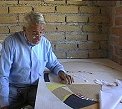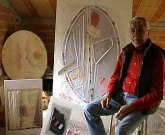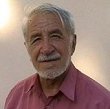"BIOGRAPHY"
 Antonio Papasso was born in Florence on 11 July 1932. His interest in art developed slowly in the tradition of the works of the
great painters. He studied closely the works in the museums of the Uffizi and the Pitti, which he visited assiduously.
Antonio Papasso was born in Florence on 11 July 1932. His interest in art developed slowly in the tradition of the works of the
great painters. He studied closely the works in the museums of the Uffizi and the Pitti, which he visited assiduously.
It was only in 1970 that he began to devote himself to art: restless and dissatisfied, he decided to move to a farmhouse in the Pisan countryside.
In this hermitage, sometimes in bitter solitude, he faced the challenge of learning more. He was frequently in the company of Luigi Ferrarino,
former cultural attachè at the Embassies in Paris and Madrid for over thirty years. He was often in the library of the Scuola Normale in Pisa,
trying to get to grips with philosophical and anthropological problems; he discovered the literary review "Il Verri" and made contact with the '63
group (Sanguineti, Giuliani and others).
He began to experiment with forms and colours with a freedom that came from having made some of Picasso's maxims his own, such as: "I have never seen
colours in conflict with each other". He applied this principle to figurative images that he created in engravings and prints, with their strident and contrasting
colours: they were small works, some of them lost, which Papasso kept in a drawer because they were rejected by friends and critics, but which he believed
in: he realised that those colours that seemed so hostile, subsided with time, transformed into new harmonies. Papasso did not abandon this experience.
He returned to it later with the pseudonym of Antigone, applying it to engravings and prints, with which he created landscapes and lake scenes with animals.
The thirst for freedom and the need for change brought to an end this first informal period with which he had presented himself to the general public, a period
he summed up in the collection of engravings GENEALOGY, published in 1976 with an introduction by Aldo Cairola.
The secret experience of Antigone, with the first test engravings and prints, at last showed him, through the use of soft tissue paper, a new language, a personal
experience of his own. The first papiers froissès signed by Papasso were born, and in 1979 he displayed them in Milan at the Zarathustra gallery, presented
by Roberto Sanesi.
At the same time as his engraving, he continued his experiments with this original technique, and two years later in 1981 he again exhibited at the Zarathustra.
These were more demanding works, and this time they were presented by Gillo Dorfles, along with the collection of engravings CANTA; one-man shows
followed in Como, Genova, Trento and Bologna.
The result was the work of engravings "Stultifera" accompanied by a poem by Roberto Sanesi.
1982 saw the publication of a collection of seven original colour prints entitled RE/SPIRA, accompanied by a triple acrostic by Edoardo Sanguineti.
The work is now part of the Collections of the Museum of Modern Art (MoMA) and the Bibliothèque Nationale de France (BNF):
"…It was accepted at the Committee's May 25 th meeting
(...) The members of the Committee were unanimously enthusiastic about
your etchings (...) it broadens our knowledge of contemporary Italian
printmakings ..." From The Museum of Modern Art - purchase of RE/SPIRA
serial of etchings - New York, 25-may-1983).
" ...les votre petite album si subtil e si délicat
et nous sommes trés heureux de l'apceter dans les collections
de la Bibliothèque Nationale..." (Bibliothèque Nationale
de France, Parigi 6 juin 1984).
Between 1982 and 1983 he produced two collections of engravings: RACCONTO, inspired by a poem dedicated to him that Alfredo Giuliani
had published in the literary review "Il Verri" followed by the collection of six colour prints entitled FORMA NATURÆ (ARCHETIPI & C.), accompanied
by a short essay by Giulio Carlo Argan.
In 1983 he moved close to Rome, where he met the collector Guglielmo Cialdi, who helped and encouraged him. Papasso spent more and more time with his
papiers froissès.
Two exhibitions in Hamburg and Budapest were followed by another in 1989 at the Charlton gallery in Rome, again presented by Gillo Dorfles.
Through Cialdi he met the gallery-owner Toninelli, who organised another group of one-man shows for him: at the Gran Palais in Paris (Fiac and Saga),
at the Toninelli Arte Moderna in Rome, and at the Palais du Festivals in Cannes and at the Arte Jonction gallery.
In 1992 he completed the collection of original colour prints with some papiers froissés PROMEMORIA-PRO/MEMORIA accompanied by a short acrostic
by Edoardo Sanguineti. This work was never published and only some studies of it were printed, one of which was later acquired by the BNF together with
the collection of engravings FORMA NATURÆ (ARCHETIPI & C.) and five other works signed Antigone: the pseudonym which Papasso used for his
coloured etchings of the joys of country life, whose "transcendental" style mixed the traditional and the surreal.
This work was never published and only some studies of it were printed, one of which was later acquired by the BNF together with
the collection of engravings FORMA NATURÆ (ARCHETIPI & C.) and five other works signed Antigone: the pseudonym which Papasso used for his
coloured etchings of the joys of country life, whose "transcendental" style mixed the traditional and the surreal.
In 1996 TELEMARKET started displaying Papasso’s works on its TV channel: this continued until 2002.
In 1999 he was invited to display his works at the Town Hall of Bracciano (Rome). The catalogue had an introduction by Edoardo Sanguineti, who
dedicated a poem to him, PENSIERINI PER PAPASSO (With Papasso in mind).
In October 2004, Tommaso Lisa’s research in the Italian Department of Florence University on Edoardo Sanguineti’s collaboration with some important
Italian artists led to the presentation of the documents of his collaboration with Papasso. The results of the research were later published in the volume
"Pretesti Ecfrastici" by the Società Editrice Fiorentina.
In January 2006 Papasso was invited to exhibit his works at the Museo di Arte Contemporanea of Rome’s "La Sapienza" University, where a
one-man show was set up curated by Cinzia Di Bari, accompanied by the monograph "Il tutto e il niente" (All and Nothing).
In October 2006 Papasso was invited to the Museo Storico dell'Aeronautica Militare at Vigna di Valle (Rome) on Lake Bracciano, where he set up an
exhibition, who also presented the book "Elogio del leggero" (Praise of Lightness) containing the SONETTO DEL FOGLIO VOLANTE (Sonnet of the Flying Sheet)
written in Papasso’s honour for the occasion by Edoardo Sanguineti. An appendix and short film d’auteur by Riccardo Barletta on Papasso’s work was
presented at the inauguration of the exhibition.
In December 2006 a short film on Papasso by Fernando Pessolano and Emilio Casalini entitled QUESTA CARTA MIA (This paper of mine) was presented
at the Palazzo dei Congressi in Rome.
Papasso was a guest on the website of the Saatchi Gallery in London in the section Saatchi On-line devoted to senior artists from all over the world.
He took part in the first online competition SHOWDOWN organised by the gallery, consisting in twelve rounds lasting one week each (with an average
of 3000 people taking part in each round) as both Papasso and Antigone, both of whom were chosen by the public and included several times in the 50
FAVOURITE works published at the end of each round. In the ten rounds Papasso was chosen 9 times and Antigone 7 times.
Recently the TV channel CONTO TV chose a work by Papasso for a special collector’s edition of 10,000 top-up cards out of an overall number
of 100,000 pieces.
Papasso has his own official website: www.papasso.net

TOP






 Antonio Papasso was born in Florence on 11 July 1932. His interest in art developed slowly in the tradition of the works of the
great painters. He studied closely the works in the museums of the Uffizi and the Pitti, which he visited assiduously.
Antonio Papasso was born in Florence on 11 July 1932. His interest in art developed slowly in the tradition of the works of the
great painters. He studied closely the works in the museums of the Uffizi and the Pitti, which he visited assiduously. This work was never published and only some studies of it were printed, one of which was later acquired by the BNF together with
the collection of engravings FORMA NATURÆ (ARCHETIPI & C.) and five other works signed Antigone: the pseudonym which Papasso used for his
coloured etchings of the joys of country life, whose "transcendental" style mixed the traditional and the surreal.
This work was never published and only some studies of it were printed, one of which was later acquired by the BNF together with
the collection of engravings FORMA NATURÆ (ARCHETIPI & C.) and five other works signed Antigone: the pseudonym which Papasso used for his
coloured etchings of the joys of country life, whose "transcendental" style mixed the traditional and the surreal.